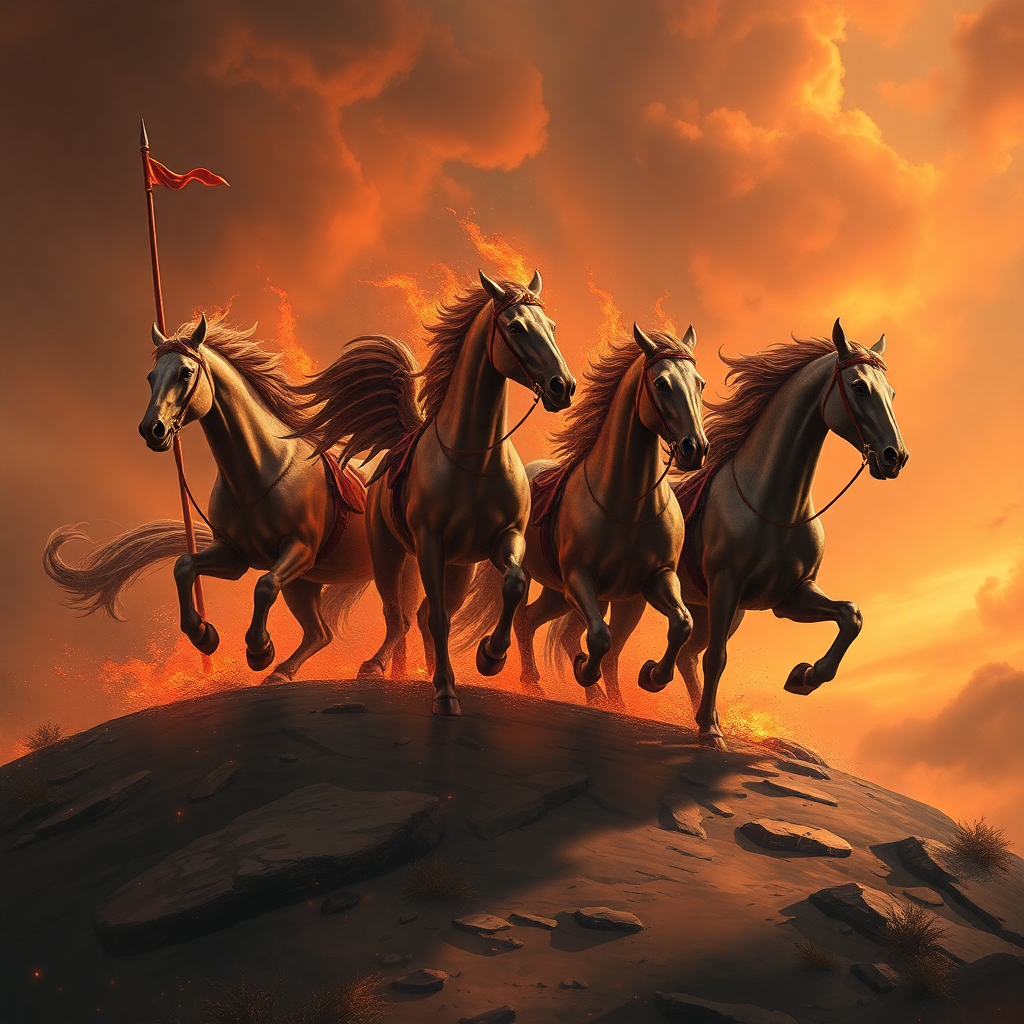Are the four horsemen of the apocalypse good?
From a theological perspective, their actions can be viewed as fulfilling God's plan for restoration. The chaos they bring ultimately leads to the establishment of a new heaven and new earth, where justice prevails.
The Four Horsemen of the Apocalypse, as described in the Book of Revelation, have captured the imagination of readers and theologians for centuries. Their imagery is striking—a powerful visual of impending doom and divine judgment—and their meanings are often subjects of interpretation and debate.
But are the Four Horsemen inherently good or evil? This blog post will explore their significance, characterizations, and the broader theological implications, ultimately seeking to answer whether these harbingers of the apocalypse can be viewed as “good.”
Understanding the Four Horsemen
The Four Horsemen are introduced in Revelation 6:1-8, where they emerge as part of the apocalyptic vision revealed to John. Each horseman rides a different colored horse and embodies a specific aspect of tribulation that will affect humanity at the end of days:
- The White Horse – The first horseman rides a white horse and carries a bow, often interpreted as representing conquest or false peace. Some interpretations suggest that this horseman symbolizes the Antichrist, a figure who appears benevolent but ultimately leads people away from true faith.
- The Red Horse – The second horseman rides a red horse and wields a sword, symbolizing war and bloodshed. His arrival signifies the emergence of conflict and violence, which is a direct result of humanity’s failure to uphold peace and justice.
- The Black Horse – The third horseman rides a black horse and holds a pair of scales. This symbolizes famine and economic disparity. The scales reflect the scarcity of resources and the imbalance that leads to suffering among people.
- The Pale Horse – The fourth horseman rides a pale horse, accompanied by Death. This horseman signifies mortality and destruction, with a grim reminder of the inevitability of death amidst chaos and suffering.
The Nature of the Four Horsemen: Agents of Judgment
When examining the nature of the Four Horsemen, it becomes crucial to consider the context in which they operate. They are portrayed as agents of divine judgment, unleashed during the end times as a response to humanity's rebellion against God. In this light, they serve a purpose: to execute judgment and bring about accountability for sin and injustice.
From a theological perspective, their actions can be viewed as fulfilling God's plan for restoration. The chaos they bring ultimately leads to the establishment of a new heaven and new earth, where justice prevails. This interpretation suggests that while the horsemen themselves represent destruction, they are not inherently evil; rather, they are instruments of God's sovereignty that reflect the consequences of human choices.

The Dichotomy of Good and Evil
Defining the horsemen as "good" or "evil" requires examining the broader implications of their arrival. In biblical theology, good and evil are often viewed not merely through the lens of individual actions, but in the context of God’s greater plan. The Four Horsemen serve as indicators of the current state of humanity and the repercussions of turning away from God.
Their presence highlights the dual nature of God's character—God is both loving and just. While the heralding of these horsemen may evoke fear, they also serve as a call to repentance and a reminder of God’s holiness. In this sense, their role can be seen as an invitation to seek redemption, underscoring the importance of faith and obedience.
The Role of Humanity in the Apocalypse
Another aspect to consider is the role humanity plays in the context of the horsemen’s arrival. Each horseman reveals the result of human choices—conflict and war come from unbridled ambition, famine arises from greed and inequality, and death is the ultimate result of sin. Therefore, the horsemen can also be interpreted as reflections of the brokenness inherent in a world that has strayed from God.
In this regard, the conversation about whether the Four Horsemen are "good" shifts from an evaluation of the horsemen themselves to a reflection on human actions and societal conditions. Their appearance serves as a sobering reminder of the consequences of sin and the urgent need for collective repentance and moral rectitude.
The Hope Beyond the Horsemen
While the image of the Four Horsemen can be unsettling, it is essential to recognize that Revelation does not end with their arrival. The message of the Apocalypse is one of ultimate hope. Following the tribulations and judgments depicted by the horsemen, Revelation culminates in a promise: the establishment of God’s kingdom, where there will be no more suffering, pain, or death (Revelation 21:4). Thus, the horsemen, while instrumental in revealing the gravity of sin and judgment, pave the way for the redemption and restoration that God promises.
Conclusion: The Complexity of Good and Evil
In conclusion, the Four Horsemen of the Apocalypse embody a complex interplay of good and evil rooted in divine judgment and human actions. While they herald tribulation, their presence is ultimately woven into the fabric of God’s redemptive plan. Rather than attempting to categorize them strictly as good or evil, it is more illuminating to view them as necessary agents of accountability, challenging humanity to confront its choices and strive for righteousness.